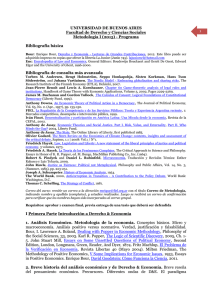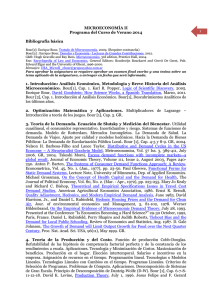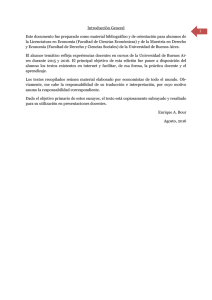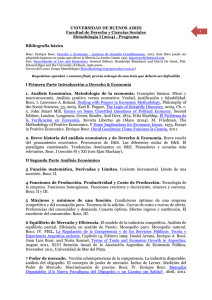Primer Semestre 2014
Anuncio
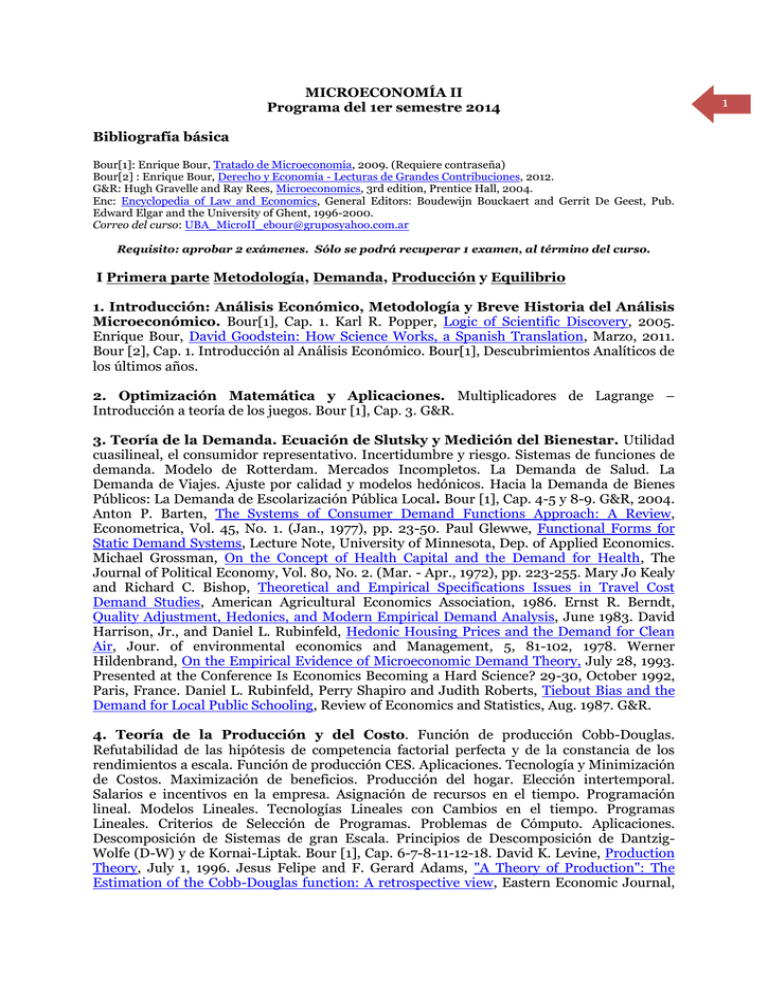
MICROECONOMÍA II Programa del 1er semestre 2014 Bibliografía básica Bour[1]: Enrique Bour, Tratado de Microeconomía, 2009. (Requiere contraseña) Bour[2] : Enrique Bour, Derecho y Economía - Lecturas de Grandes Contribuciones, 2012. G&R: Hugh Gravelle and Ray Rees, Microeconomics, 3rd edition, Prentice Hall, 2004. Enc: Encyclopedia of Law and Economics, General Editors: Boudewijn Bouckaert and Gerrit De Geest, Pub. Edward Elgar and the University of Ghent, 1996-2000. Correo del curso: [email protected] Requisito: aprobar 2 exámenes. Sólo se podrá recuperar 1 examen, al término del curso. I Primera parte Metodología, Demanda, Producción y Equilibrio 1. Introducción: Análisis Económico, Metodología y Breve Historia del Análisis Microeconómico. Bour[1], Cap. 1. Karl R. Popper, Logic of Scientific Discovery, 2005. Enrique Bour, David Goodstein: How Science Works, a Spanish Translation, Marzo, 2011. Bour [2], Cap. 1. Introducción al Análisis Económico. Bour[1], Descubrimientos Analíticos de los últimos años. 2. Optimización Matemática y Aplicaciones. Multiplicadores de Lagrange – Introducción a teoría de los juegos. Bour [1], Cap. 3. G&R. 3. Teoría de la Demanda. Ecuación de Slutsky y Medición del Bienestar. Utilidad cuasilineal, el consumidor representativo. Incertidumbre y riesgo. Sistemas de funciones de demanda. Modelo de Rotterdam. Mercados Incompletos. La Demanda de Salud. La Demanda de Viajes. Ajuste por calidad y modelos hedónicos. Hacia la Demanda de Bienes Públicos: La Demanda de Escolarización Pública Local. Bour [1], Cap. 4-5 y 8-9. G&R, 2004. Anton P. Barten, The Systems of Consumer Demand Functions Approach: A Review, Econometrica, Vol. 45, No. 1. (Jan., 1977), pp. 23-50. Paul Glewwe, Functional Forms for Static Demand Systems, Lecture Note, University of Minnesota, Dep. of Applied Economics. Michael Grossman, On the Concept of Health Capital and the Demand for Health, The Journal of Political Economy, Vol. 80, No. 2. (Mar. - Apr., 1972), pp. 223-255. Mary Jo Kealy and Richard C. Bishop, Theoretical and Empirical Specifications Issues in Travel Cost Demand Studies, American Agricultural Economics Association, 1986. Ernst R. Berndt, Quality Adjustment, Hedonics, and Modern Empirical Demand Analysis, June 1983. David Harrison, Jr., and Daniel L. Rubinfeld, Hedonic Housing Prices and the Demand for Clean Air, Jour. of environmental economics and Management, 5, 81-102, 1978. Werner Hildenbrand, On the Empirical Evidence of Microeconomic Demand Theory, July 28, 1993. Presented at the Conference Is Economics Becoming a Hard Science? 29-30, October 1992, Paris, France. Daniel L. Rubinfeld, Perry Shapiro and Judith Roberts, Tiebout Bias and the Demand for Local Public Schooling, Review of Economics and Statistics, Aug. 1987. G&R. 4. Teoría de la Producción y del Costo. Función de producción Cobb-Douglas. Refutabilidad de las hipótesis de competencia factorial perfecta y de la constancia de los rendimientos a escala. Función de producción CES. Aplicaciones. Tecnología y Minimización de Costos. Maximización de beneficios. Producción del hogar. Elección intertemporal. Salarios e incentivos en la empresa. Asignación de recursos en el tiempo. Programación lineal. Modelos Lineales. Tecnologías Lineales con Cambios en el tiempo. Programas Lineales. Criterios de Selección de Programas. Problemas de Cómputo. Aplicaciones. Descomposición de Sistemas de gran Escala. Principios de Descomposición de DantzigWolfe (D-W) y de Kornai-Liptak. Bour [1], Cap. 6-7-8-11-12-18. David K. Levine, Production Theory, July 1, 1996. Jesus Felipe and F. Gerard Adams, "A Theory of Production": The Estimation of the Cobb-Douglas function: A retrospective view, Eastern Economic Journal, 1 Vol. 31, No. 3, Summer 2005. K. J. Arrow, H. B. Chenery, B. S. Minhas and R. M. Solow, Capital-Labor Substitution and Economic Efficiency, The Review of Economics and Statistics, Vol. 43, No. 3 (Aug., 1961), pp. 225-250. George B. Dantzig, II. The Programming of Interdependent Activities: Mathematical Model, in Tjalling C. Koopmans, Activity Analysis of Production and Allocation, in Cooperation with Armen Alchian, George B. Dantzig, Nicholas Georgescu-Roegen, Paul A. Samuelson and Albert W. Tucker, Proceedings of a Conference, 1951. David Gale, Linear Programming and the Simplex Method, Notices of the AMS Volume 54, Number 3, March 2007. Peter Orazem, Household Production Theory, 2003, Iowa University. Gary S. Becker, A Theory of the Production and Allocation of Effort, NBER Working paper, July 1977. Robert S. Pindyck and Julio J. Rotemberg, Dynamic Factor Demands under Rational Expectations, The Scandinavian Journal of Economics, 1983, in Melvyn Fuss and Daniel McFadden, Volume II. Applications of the Theory of Production, Production Economics: A Dual Approach to Theory and Applications, Editors, Amsterdam: North-Holland, 1978. George B. Dantzig and Philip Wolfe, Decomposition Principle for Linear Programs, Operations Research 1960 8:1, 101-111. J. Kornai and Th. Lipták, TwoLevel Planning, Econometrica, Vol. 33, No. 1 (Jan., 1965), pp. 141-169. Lee, Sang M and Rho, B., Computational Experience With the Dantzig-Wolfe and Kornai-Lipták Decomposition Algorithm, International Journal of Policy and Information (1986) Vol. 10, No. 1. J. Kornai, Plan y Mercado, Un Aporte a la controversia (1st World Congress of the Econometric Society, Rome, 9 to 14 September 1965) (traducción). FIEL, La Regulación de la Competencia y de los Servicios Públicos: Teoría y Experiencia Argentina reciente, Capítulo 13, Febrero 1999. Daniel Artana, Enrique A. Bour, Juan Luis Bour, and Nuria Susmel, Terms of Trade and Economic Growth in Argentina, August 2011, XLVI Reunión Anual de la Asociación Argentina de Economía Política, November 2011, Universidad de Mar del Plata. G&R. 5. Mercados. Equilibrio, estática comparativa y estabilidad. Equilibrio parcial competitivo. El enfoque schumpeteriano de la competencia. Monopolios clásico, natural y disputable. Poder de Mercado; competencia monopolística, oligopolio y monopsonio. Duopolio de Cournot. Modelo de Stackelberg. Modelo de Bertrand. Modelo de demanda quebrada de Sweezy e Hitch. Modelo de Edgeworth. Empresa Dominante. Modelo de Chamberlin. Bour [1], Cap. 15 y 17. Enrique Bour. Mercados Disputables ¿Un Nuevo Paradigma del Oligopolio o un Camino sin Salida?, Abril, 2011. Joseph McCauley, Thermodynamic analogies in economics and finance: instability of markets, Physica A 329: 199–212, (2003). Pradeep Dubey and Dieter Sondermann, Perfect Competition in a Bilateral Monopoly (In honor of Martin Shubik), Cowles Foundation Discussion Paper, September 2005. Stanley Reiter, Kenneth Arrow, Lance Davis, Paul Dimaggio, Mark Granovetter, Jerry Green, Theodore Groves, Michael Hannan, Andrew Postlewaite, Roy Radner, Karl Shell and Leonid Hurwicz, Kellogg Northwestern Final Report, Markets and Organizations. Jean-Michel Grandmont, Cowles Foundation Discussion Paper, Behavioral Heterogeneity and Cournot Oligopoly Equilibrium. 1993. Henry Manne, Insider Trading: Hayek, Virtual Markets and the Dog that Did Not Bark, bepress Legal Series, 2005. Michael A. Heller, The Tragedy of the Anticommons: Property in the Transition from Marx to Markets, 111 Harv. L. Rev. (1998) and SSRN. Ricardo J. Caballero and Arvind Krishnamurty, Emerging Market Crises: An Asset Markets Perspective, NBER, December 1998. Alfred Cowles 3rd, Can Stock Markets Forecasters Forecast? December, 1932. Robert A. Mundell, Hicksian Stability, Currency Markets, and the Pure Theory of Economic Policy, Ch. 21 of "International Economics", Macmillan, 1968. Marcella Scrimitore, Managerial Incentives and Stackelberg Equilibria in Oligopoly, EERI Research Paper, 2010. Jeremy I. Bulow, John D. Geanakoplos and Paul D. Klemperer, Multimarket Oligopoly: Strategic Substitutes and Complements, The Journal of Political Economy, Vol. 93, No. 3 (Jun., 1985), pp. 488-511. Stephen Cheung. Notes Towards a Simplified Pedagogy of Oligopoly Theory, Innovation for Student Engagement in Economics: Proceedings of the Eleventh Australasian Teaching Economics Conference, Stephen L. Cheung, ed., pp. 13-22, 2005. James W. Friedman, On Experimental Research in Oligopoly, Cowles Foundation Discussion Paper, February, 1968. G&R. 2 6. Modelo de Walras y Equilibrio General Competitivo. Eficiencia. Modelo de intercambio de Walras. Análisis de equilibrio general y teoremas de punto fijo. Modelo de Arrow-Debreu. Teorema de Sonnenschein- Debreu-Mantel. Eficiencia en sentido de Pareto. Los dos primeros teoremas de la Economía del Bienestar. El problema del second-best o 3º teorema de la economía del bienestar. Bour [1], Cap. 19-20-21. Murray C. Kemp y Koji Shimomura, The Sonnenschein–Debreu–Mantel Proposition and the Theory of International Trade, Review of International Economics (2002), 10: 671–679. Fernando Tohmé, Rolf Mantel and the Computability of General Equilibria: On the Origins of the Sonnenschein-Mantel-Debreu Theorem, History of political economy, Nº 5, 2007, pags. 213227. Richard G. Lipsey, Reflections on the General Theory of Second Best at its Golden Jubilee, A key note address presented to the 62th Congress of the International Institute of Public Finance. G&R, 2004. II Segunda Parte Derecho y Economía 7. Bienes públicos, externalidades y teoría de los incentivos. Imposibilidad de descentralizar la provisión de bienes públicos según Samuelson. La solución de Tiebout. La solución de Falkinger. Externalidades y calentamiento global. Criminalización, responsabilidad civil extra-contractual, provisión por el Gobierno e impuestos y subsidios como soluciones institucionales alternativas. Teoría de los incentivos. Bour[2], V – Bienes Públicos, externalidades y teoría de los incentivos. María P. Cacault, E. A. Bour, D. Álvarez, Iris Ceñal, Romina Job y Antonella di Menna, Otro Problema Económico: El Cambio Climático Global, FIEL, Indicadores de Coyuntura, Nº 492, Oct. 2008. James M. Buchanan, The Demand and Supply of Public Goods, (Liberty Fund, 1999). Charles M. Tiebout, A Pure Theory of Local Expenditures, The Journal of Political Economy, Vol. 64, No. 5. (Oct., 1956), pp. 416-424. Ekaterina V. Zhuravskaya, Incentives to provide local public goods: fiscal federalism, Russian style, Journal of Public Economics 76 (2000) 337–368. David Osterfeld, Anarchism and the Public Goods Issue: Law, Courts, and the Police, Journal of Libertarian Studies 9:1 (Winter 1989): 47-68. Jeffrey Rogers Hummel, National Goods Versus Public Goods: Defense, Disarmament, and Free-Riders, The Review of Austrian Economics, Vol. 4, 1990, p. 86-122. Jerry Green and Jean-Jacques Laffont, Characterization of Satisfactory Mechanisms for the Revelation of Preferences for Public Goods, Econometrica, Vol. 45, No. 2 (Mar., 1977), pp. 427-438. Theodore Groves and John Ledyard, Optimal Allocation of Public Goods: A Solution to the "Free Rider" Problem, Econometrica, Vol. 45, No. 4 (May, 1977), pp. 783-809. John Roberts, Incentives in Planning Procedures for the Provision of Public Goods, The Review of Economic Studies, Vol. 46, No. 2 (Apr., 1979), pp. 283-292. Joseph P. Kalt, Public goods and the theory of government, Cato Journal, Vol. 1, No. 2 (Fall 1981). Robert H. Strotz, Two Propositions Related to Public Goods, The Review of Economics and Statistics, Vol. 40, No. 4. (Nov., 1958), pp. 329-331. Theodore Bergstrom and Richard Cornes, Independence of Allocative Efficiency from Distribution in the Theory of Public Goods, Econometrica, 51(6), 1983. Mark Bagnoli and Barton L. Lipman, Provision of Public Goods: Fully Implementing the Core through Private Contributions, The Review of Economic Studies, vol. 56, Nº 4 (Oct., 1989). Walter Block, Public Goods and Externalities: The Case of Roads, The Journal of Libertarian Studies, Vol. VII, Nº 1 (Spring 1983). Robert Aumann with M. Kurz and A. Neymann, Voting for Public Goods, Review of Economic Studies 50 (1983). 8. Planificación centralizada. Pensamiento de Marx y el marxismo. Acumulación capitalista y extracción del excedente. Explotación. La teoría del valor-trabajo. Modelo de insumo-producto abierto de Leontief. Valores y teorema fundamental del marxismo (Morishima). Breve historia de la URSS. Economías planificadas: algunas nociones teóricas. Las críticas de Oskar Lange ¿Existe un futuro para el socialismo? Críticas de Friedrich A. Hayek. Organizaciones institucionales alternativas: El modelo Nórdico. Bour[1], VI – 3 Socialismo y planificación central. Bour[2], XIV – Grandes pensadores de L&E, El problema del conocimiento: Friedrich Hayek. Lawrence R. Klein, On the Interpretation of Professor Leontief's System, Review of Economic Studies, 20, 1953. Naoki Yoshihara, Reexamination of the Marxian Exploitation Theory, Discussion Paper Series A No. 481, May 2006, The Institute of Economic Research, Hitotsubashi University. Friedrich Hayek, The Use of Knowledge in Society, American Economic Review, XXXV, No. 4; September, 1945, 519-30. Friedrich A. Hayek, The Fatal Conceit – The errors of socialism, Edited by W. W. Bartley, III, 1988, Routledge. Friedrich A. Hayek, Socialism and Science, Lecture, Economic Society of Australia and New Zealand, October, 1976. Eugen von Böhm-Bawerk, Karl Marx and the Close of his System, London, 1898, traducción de Alice M. Macdonald. Oskar Lange, The Computer and the Market, 1967, in C. H. Feinstein, ed., Socialism, Capitalism and Economic Growth, Cambridge University Press. Oskar Lange, Price Flexibility and Employment, Appendix – The Stability of Economic Equilibrium, The Principia Press, 1944. Torben M. Andersen, Bengt Holmström, Seppo Honkapohja, S. Korkman, Hans Tson Söderström, Juhana Vartiainen, The Nordic Model - Embracing globalization and sharing risks, The Research Institute of the Finnish Economy (ETLA), Yliopistopaino, Helsinki, 2007. 9. Sistemas descentralizados. Capitalismo. Atributos Básicos de los sistemas socialista y capitalista. Responsabilidad Social de la Empresa. Regulación pública del sector privado. La regulación del sector eléctrico. El caso del regulador con una “agenda privada” y necesidad de la descentralización. Sociedades Público-Privadas. Bour[2], VII – Sistema capitalista y capitalismo regulatorio. János Kornai, What the Change from Socialism to Capitalism Does and Does not Mean, Journal of Economic Perspectives-Volume 14, Nº IWinter 2000-Pages 27-42 (traducción). János Kornai, Hardening the budget constraint: The Experience of the post-socialist Countries, European Economic Review, 2001, 45/9: 15731600. Enrique Bour, Responsabilidad Social de la Empresa – Análisis del Concepto, Estudios Económicos. Vol. XXIX (N.S.), Nº 59, Julio-Diciembre 2012, 1-30. Jean-Jacques Laffont and Jérôme Pouyet, The subsidiarity bias in regulation, Journal of Public Economics, Volume 88, Issues 1-2, January 2004, Pages 255-283. Raaj Kumar Sah and Joseph E. Stiglitz, The Architecture of Economic Systems: Hierarchies and Polyarchies, The American Economic Review, Volume 76, Issue 4 (Sep., 1986), 716-727. 10. Corrupción. La corrupción como un problema del estado. La corrupción en Argentina. Índices de transparencia de diversas fuentes. La tragedia de los bienes comunales. Aporte de Alfredo Canavese. Corrupción, inversión pública y estancamiento. Tipología de la corrupción. Captura regulatoria. ¿Quién captura a quién? La experiencia de los ex países socialistas para evaluar la situación argentina. Consecuencias económicas y sociales de la corrupción. Credibilidad del estado. Corrupción en el cobro de impuestos y en la regulación. Probabilidad de detección y corrupción. Severidad del castigo. Bour[2], VIII – Corrupción. A. Shleifer and R.W. Vishny, Corruption, 1993, Quarterly Journal of Economics 108, 599-617. Susan Rose-Ackerman, Corruption and the global economy, in Corruption and the global economy, ed. Kimberly Ann Elliott, Institute for International Economics, 1997. Johann Graf Lambsdorff, Corruption and rent-seeking, Public Choice 113: 97-125, 2002. Susan RoseAckerman, The Political Economy of Corruption, in Corruption and the global economy ed. Kimberly Ann Elliott, Institute for International Economics, 1997. Patrick Glynn, Stephen J. Kobrin, and Moisés Naím, The Globalization of Corruption, Corruption and the Global Economy, edited by Kimberley Ann Elliot, Peterson Institute for International Economics, 1997. Alfredo Canavese, Temas en el Análisis Económico de los Derechos de Propiedad, Revista de Economía Política de Buenos Aires, Año 1, Vol. 1, Mar. 2007. World Bank, 2000, Anticorruption in Transition - A Contribution to the Policy Debate. The World Bank: Washington, D.C. Bruce L. Benson and John Baden, The Political Economy of Governmental Corruption: The Logic of Underground Government, The Journal of Legal Studies, Vol. 14, No. 2, (Jun., 1985), pp. 391-410. 4 11. Justicia y Derecho. Teoría económica y equilibrios de Nash. Teoría de los juegos y su utilización en las ciencias sociales. Dilema del prisionero. Juego de la seguridad. Juego del imperativo categórico. Juego del gallina. ¿Puede la cooperación surgir en forma espontánea entre individuos egoístas? Aplicaciones en derecho. Equilibrios focales. Patologías sociales y raíces culturales de la pobreza. Derechos de propiedad y justicia. La guerra de las Malvinas. Teoría de los juegos y derecho. La Justicia como Imparcialidad. El Contrato. La Propiedad. El origen y la justificación de la autoridad pública. Los bienes públicos como justificación del Estado. El poder como origen del Estado. El dilema del poder. Los derechos fundamentales del ciudadano. La paradoja de las democracias populares. Las reglas legales como súperestructura. Ken Binmore, Game Theory and Institutions, 2009. David D. Friedman, A Positive Account of Property Rights. Social Philosophy and Policy 11 Nº 2 (Summer 1994). Bour[2], IX – Teoría de los juegos, Justicia y Derecho. Jean-Pierre Benoît and Lewis A. Kornhauser, Chapter 60 Game-theoretic analysis of legal rules and institutions, Handbook of Game Theory with Economic Applications, Volume 3, 2002, Pages 2229-2269. John Rawls, Justice as Fairness: Political not Metaphysical, Philosophy and Public Affairs, Vol. 14, No. 3, (Summer, 1985), pp. 223-251. Fabienne Peter, Rawlsian Justice, in Paul Anand, Prasanta Pattaniak, and Clemens Puppe (eds.) The Handbook of Rational and Social Choice, 2009. Anthony De Jasay, Economic Theories and Social Justice. Part I. Risk, Value, and Externality, Part II. Who Minds the Gap? 2004, Liberty Fund. Friedrich Hayek, Law, Legislation and Liberty: A new statement of the liberal principles of justice and political economy, 3 volumes, 1973. Anthony de Jasay, The State, Library of Economics and Liberty, first published 1985. Thomas C. Schelling, The Strategy of Conflict, 1981. 12. Instituciones e Historia Económica. Historia de Derecho y Economía. Las instituciones y la compatibilidad con los incentivos. Instituciones y teoría de los juegos. La Nueva Economía Institucional. Instituciones e historia económica. Estado natural y sociedad abierta. El caso de América Latina. Bour[2], XI – Teoría de las Instituciones e Historia Económica. Bour y Ejan Mackaay [2], XII – Historia de la Disciplina Derecho & Economía. Leonid Hurwicz, But Who Will Guard the Guardians? American Economic Review, June 1998, 98(3): 577–85. Douglass C North, John Joseph Wallis, and Barry R. Weingast, A Conceptual Framework for Interpreting Recorded Human History, NBER Working Paper No. 12795, Issued in December 2006. Claudio Véliz, La tradición centralista en América Latina (introducción), Revista de Estudios Internacionales, Vol. 13, No. 50 (1980). Pranab Bardhan, History, Institutions, and Underdevelopment, Scarcity, Conflicts and Cooperation: Essays in Political and Institutional Economics of Development (MIT Press, December 2004) (traducción). Oxford: Oxford University Press, 2006. Bingyuan Hsiung, An Interpretation of Ronald Coase’ s Analytical Approach, History of Economics Review, 2004, 12-32. Iván Finot, Descentralización en América Latina: Teoría y Práctica, CEPAL, May 2001. 13. Temas de Derecho y Economía. Costo del crimen. La búsqueda de rentas. Cantidad eficiente de crimen en una sociedad. Monto óptimo de la multa. Responsabilidad por accidentes. Análisis económico de la responsabilidad civil. Pigou y Coase: asignación de recursos con externalidades. Teorema de Coase. Discriminación laboral. Formas de regulación de precios. Derecho y Economía y la regulación de instituciones financieras. Bour[2], XIII – Economía del crimen, accidentes, responsabilidad civil y regulación. David D. Friedman, Law and Economics, The Concise Encyclopedia of Economics, 2002. Anne O. Krueger, The Political Economy of the Rent-Seeking Society, American Economic Review 64 (1974). Guido Calabresi and Jon T. Hirschoff, Toward a Test for Strict Liability in Torts, 81 Yale. L.J. 1055 (1971-1972). Gordon Tullock, The Fundamentals of Rent-Seeking, The Locke Luminary Vol. I, No. 2 (Winter 1998). Bour[1], XIV – Grandes pensadores de L&E: Ronald Coase. A. C. Pigou, The Economics of Welfare, 1920. William J. Baumol, On Taxation and the Control of Externalities, The American Economic Review, Vol. 62, No. 3 (Jun., 1972), pp. 307-322. Ronald H. Coase, The Problem of Social Cost, The Journal of Law and Economics 5 (October 1960). Leonid Hurwicz, What is the Coase Theorem? Japan and the World Economy 7 (1995) 49-74. Enc, Stewart Schwab, Employment Discrimination. Enc, Janet Netz, Price Regulation: A (Non Technical) Overview. Enc, Richard L. Gordon, Law and Macroeconomics. 14. Public Choice. Teoremas de imposibilidad de Arrow y de Gibbard-Satterthwaite. El Votante Mediano y los Ciclos Económicos Políticos. Economía experimental. Análisis del liberalismo de Amartya K. Sen. Max Weber: la Burocracia y sus variantes. Análisis económico de la burocracia. Modelo de Niskanen. Teoría positiva de la Burocracia Pública. La Burocracia en Argentina. Kenneth J. Arrow, A Difficulty in the Concept of Social Welfare, The Journal of Political Economy, Vol. 58, No. 4 (Aug., 1950), pp. 328-346. James M. Buchanan and Gordon Tullock, The Calculus of Consent: Logical Foundations of Constitutional Democracy (Liberty Fund, 1999). Anthony Downs, An Economic Theory of Political Action in a Democracy, The Journal of Political Economy, Vol. 65, No. 2. (April, 1957), p. 135-150. Roger D. Congleton, The Median Voter Model, The Encyclopedia of Public Choice, 2003, Part 2, 707-712. Elizabeth Hoffman and Matthew L. Spitzer, The Coase Theorem: Some Experimental Tests, Journal of Law and Economics, Vol. 25, No. 1 (April, 1982), pp. 73-98. Amartya Kumar Sen, 1970, The impossibility of a Paretian liberal. Journal of Political Economy 78(1): 152-157. Bour[1],– Public Choice, I y II, Capítulos XVIII y XIX. William A. Niskanen, The Peculiar Economics of Bureaucracy, The American Economic Review, Vol. 58, No. 2, American Economic Association (May, 1968), pp. 293-305. Anthony Downs, Inside Bureaucracy, RAND Co., 1964. Mathew D. McCubbins and Thomas Schwartz, Congressional Oversight Overlooked: Police Patrols versus Fire Alarms, American Journal of Political Science, Vol. 28, No. 1 (Feb., 1984), pp. 165-179. Terry M. Moe and William G. Howell, Unilateral Action and Presidential Power: A Theory, Presidential Studies Quarterly 29, no. 4 (December 1999). III Tercera parte Economía Financiera 15. Tópicos de economía financiera. Teorías modernas de la elección de cartera. Diversificación de activos. Apalancamiento. Riesgo sistemático y específico. Especulación: uso correcto del concepto. Capacidad de proyección de variables económicas de los especuladores. Modelos de la especulación. Instrumentos derivados. Frontera eficiente. Modelo CAPM. Teorema de Modigliani-Miller. Anatomía de las crisis financieras. Bour[1], XXXI – Economía Financiera. Franco Modigliani and Merton H. Miller, The Cost of Capital, Corporation Finance and the Theory of Investment, The American Economic Review, Vol. 48, No. 3 (Jun., 1958), pp. 261-297. Eugene Fama, Efficient Capital Markets: A Review of Theory and Empirical Work, The Journal of Finance, Vol. 25, No. 2, Papers and Proceedings of the Twenty-Eighth Annual Meeting of the American Finance Association New York, N.Y. 28-30, 1969 (May, 1970), pp. 383-417. Hendrik S. Houthakker, Can Speculators Forecast Prices? Cowles Foundation Paper Nr 112. Robert J. Shiller, Speculative Prices and Popular Models, The Journal of Economic Perspectives, Vol. 4, No. 2. (Spring, 1990), pp. 55-65. Parag A. Pathak and Jean Tirole, Speculative Attacks and Risk Management, August 2006. Koichi Hamada, A Comparison of Currency Crises Between Asia and Latin America, in Enrique Bour, Daniel Heymann and Fernando Navajas (Eds.), Latin American Economic Crises, Trade and Labour. Palgrave McMillan, Dec. 2003. 6

